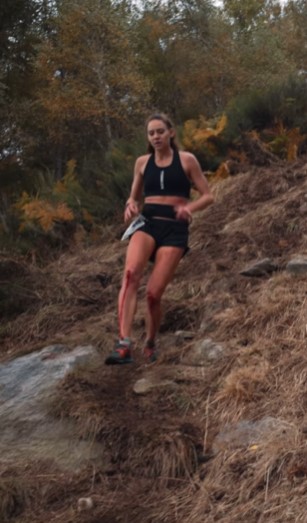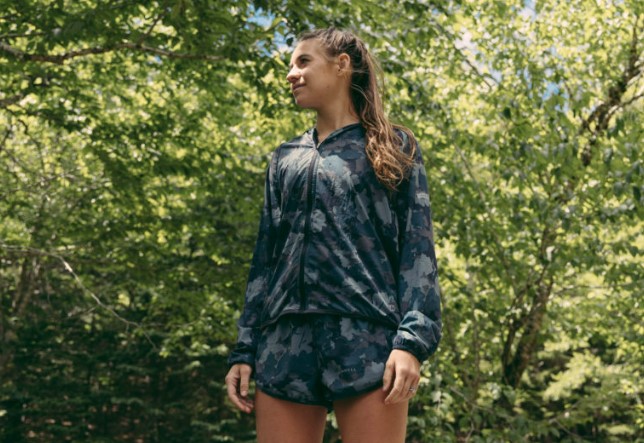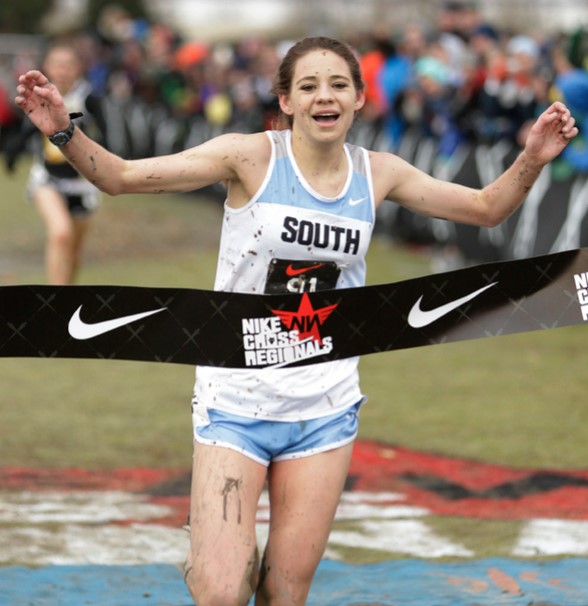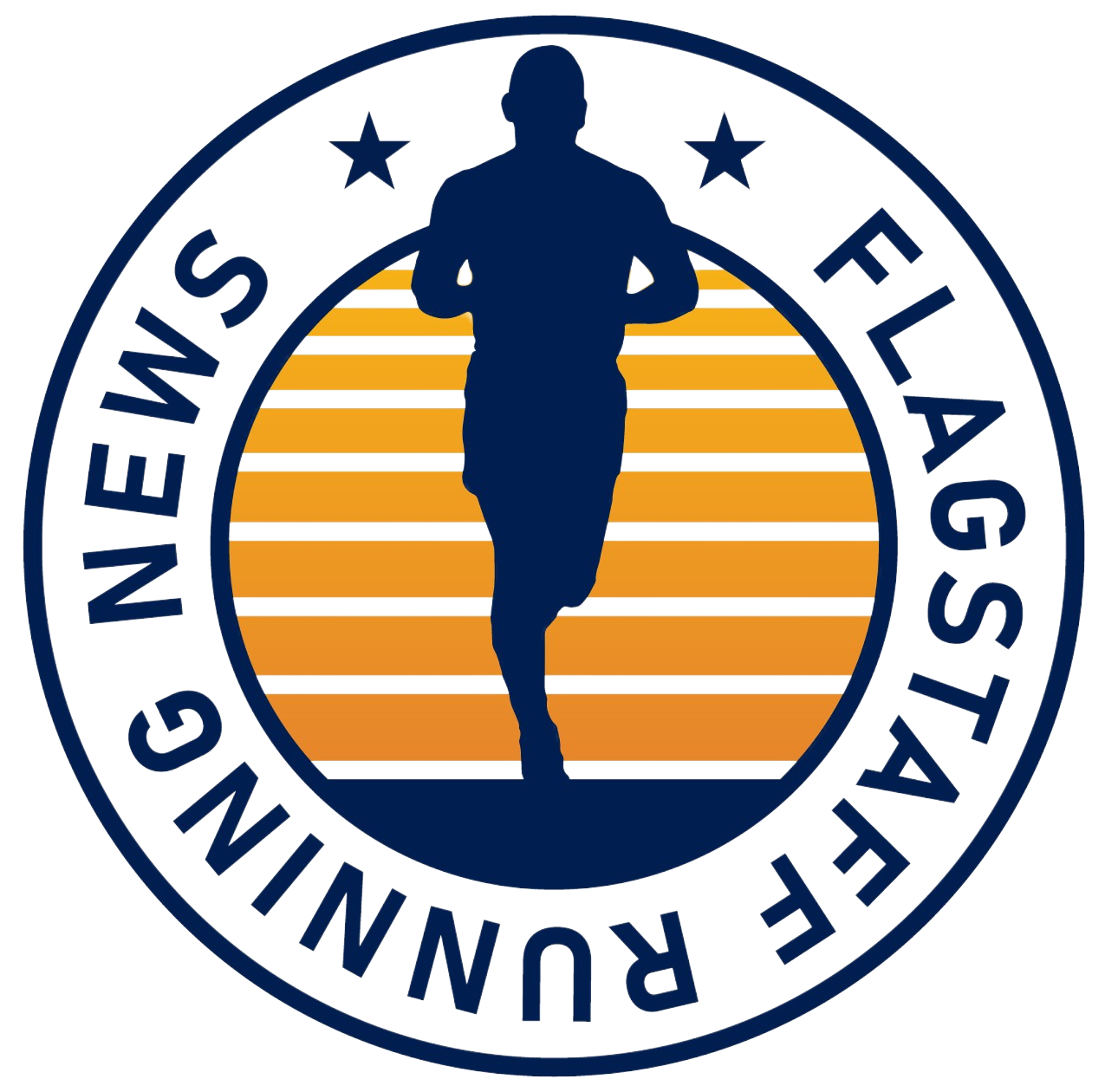She always was an outstanding and versatile runner. You don’t win the Nike Cross Nationals and place second at Foot Locker in high school without having innate ability and desire. Nor do you become a top five NCAA Cross Country finisher and Olympic Trails qualifier in the steeplechase without having extraordinary range.
Still, when Rachel Tomajczyk turned to mountain running, then the sub-ultra world of the Golden Trail Series, it may have surprised some.
Remember, Tomajczyk (née Johnson) grew up in Plano, Texas – “flat,” she laughed, “a plain!”—and went to college at Baylor, which was even flatter and lower in elevation. Her first pro team, Furman Elite, was in South Carolina, also absent a lot of huge vertical trails. No intrepid mountain woman, she.
And yet now, a few years down the road at age 31, Tomajczyk is one of the world’s best sub-ultra trial runners, routinely scaling huge heights of up to 50 percent gradients and bombing down 30 percent downhills amid rocks, roots, scree and other hazards. This fall, she placed 11th overall in the Golden Trail Series, a prestigious European circuit that draws runners from across the globe.
So, the natural question is: how did this flatlander – a track and road runner, essentially, for the first 25 years of her life – take so quickly and so expertly to major Vert?
Short answer: Well, there is no short answer.
It’s been something of an evolution for Tomajczyk, who lives and trains in Williams with her husband, Drew. A cycle of injuries and disappointments in her track career had her thinking of expanding her professional running horizons and, she admits, wondering whether she still had a future as a pro.
Her transition began a few years ago, when she was living in Flagstaff and training under the tutelage of Ryan Hall (who since has left coaching). She became friends with other steeplechasers then based in Flagstaff, Grayson Murphy and Courtney Barnes, both of whom eventually migrated to the trails.
So, that initial exposure planted the seed in Tomajczyk. But it was only after she left Flagstaff in the fall of 2019 to become a cross country coach at Liberty University in Lynchburg, Va., that she first took to the trails, first with members of Liberty’s women’s team and then on her own. She was still being coached by Hall at that point, but her career was stagnant.
What Tomajczyk found on the trails around Virginia, both on campus and less than an hour away on the famed Appalachian Trail, was renewed joy and desire. And, she found, she was darn good at trail running.
“I was trying to refocus and see if this pro running thing was going to work out,” recalled Tomajczyk over coffee at Brewed Awakenings in downtown Williams. “At Liberty, they have miles and miles of trails on campus. I’d run easy miles with the girls on trails and when I was feeling burned out running on road and track I took time to run easy on trails.”

Not only did she like the switch to the trails, she found that the move also seemed to solve a years-long string of injuries that hampered her pro track and road racing career, first as a member of the erstwhile Furman Elite team and then under Hall.
Tomajczyk visibly winces when detailing her pre-trail running injury history, starting with Furman Elite.
“OK, well, two bouts of Achilles, about every six months got injured,” she said. “Actually, first it was the Achilles, then I broke a metatarsal, then another Achilles injury, then it was post-tibial tendonitis, follow by another Achilles. Then, after Furman and out in Flagstaff, I got a stress fracture in my femur. It was a challenging time.”
Asked if she ever found the source of her near-chronic injury pattern, Tomajczyk said she believes it may have stemmed from a period when she had an eating disorder at Baylor.
“The eating disorder in college, I think, it just caught up with me (as a pro),” she said. “The first couple of years in college, I struggled to adjust (running-wise) and made some (unfortunate) decisions about sleep and nutrition and having your mind in the game.
“In high school, I was running out in front and then in college, I’m like 50th. You’re racing fifth- or sixth-year seniors and people from all over the world. My senior year, my coach and athletic training team took me aside and was like, ‘Hey, we really don’t think you’re healthy right now, we need to back off.’”
At 5-foot-6, she said she weighed in at 100 to 105 pounds, considered exceedingly underweight.
“It was not good,” she recalled. “I knew it, too. Yeah, I did well my senior year. But that’s the thing with eating disorders; they don’t really catch up with you until two or three years later. The (Baylor staff) encouraged me into rehab for part of my senior year while still racing and training and stuff and doing fine.”
More than fine, actually. Tomajczyk placed fifth in the 2014 NCAA Cross Country Championships, ahead of the likes of Shelby Houlihan, Elise Cranny, Courtney Frerichs and Molly Seidel.
She always knew she had the talent, going back to Plano Senior High, where she won NXN in 2010 and finished second overall at the Foot Locker a few weeks later. Even though she competed in the 2016 Olympic Trails in the steeple a year after graduating from Baylor, Tomajczyk failed to live up to her own high standards.
Blame injuries, of course. But maybe, too, Tomajczyk had just yet to find her running niche.
And it turned out to be on the trails. Not the ultrarunning suffer-fests of 100-mile races and beyond, but the shorter, speedier and arguably more harrowing world of sub-ultra races at distances ranging from 10 to 40 kilometers.

It was in 2021 when she finally made the switch. She didn’t exactly dip her toe into trail racing; no, Tomajczyk jumped in head-first, while still living and coaching in Lynchburg.
Her debut race was the U.S. Mountain Running Championships that August at the Gnar Gnar Trail Climb (six miles, up and down) at the Mount Hood (Ore.) Skibowl. She finished second to Murphy, who then was training out of Bozeman, Mont., and earned a spot on the U.S. Mountain team at the World Championships in Thailand.
“I signed up just to see if I liked it,” Tomajczyk said, laughing. “That’s how it all started. … When I was training in Virginia, the trails were really techy and rocky, and I remember following friends on Strava who are into trails and thinking, ‘How can they go downhill this fast?’ Because I’m going 10-minute pace downhill, and I didn’t know how they’re able to go 5:30 or 6-minute pace. But then I got out there at the race, and it was really smooth bike trail and it was a lot easier than I thought, coming, you know, from East Coast trails.”
After that initial race, success on the trails just kept coming. It got to the point that Tomajczyk was doing so well on the trail circuit, both in the U.S. and internationally, that she decided to take the plunge and do it fulltime. That happened a little after she took the plunge and got married.
Her husband, Drew, was a former collegiate tennis player turned body builder turned hybrid runner/lifter. The two met in what sounds like the plot of a rom-com movie: Drew was listening to Ryan Hall’s running podcast and the guest was Rachel. After listening, he found her online, and …
Well, let’s let Rachel pick up the narrative strand.
“He heard the episode and thought, ‘She’s really cool,’ then he learned I lived in Virginia, which was two hours away from where he lived,” she said. “He reached out and DM’d me for coaching and we had a phone call and didn’t talk about coaching at all. We ended up going out on a date. I coach him now, though. So he did get a coach out of it.”
With her wedding approaching, Tomajczyk faced another threshold-like event: a career change. She could stay coaching at Liberty and pursue trail running, or she could go all in on pro trail running and move to a high-altitude locale. Drew was willing to relocate, and the two had a long talk.
“Drew asked me, “If you could live anywhere, where would you live?’” she recalled. “I said Flagstaff. But I had been planning to just continue to coach and he’d move to Lynchburg while I kept training. But we looked at job openings on his company’s website, and there was an opening in Williams. Well, that’s pretty wild.”
Through 30 miles or so west of Flagstaff, Williams was close enough. Tomajczyk threw herself into the trail life, becoming a regular running up Humphreys Peak and power hiking the ski runs at the Snowbowl, as well as haunting the forest roads around Williams and Flagstaff.
Her career took off so quickly. She competed in the Golden Trail Series in 2022 and held her own, though failing to make the series final. In 2023, she placed 22nd at the series, and she also won the XTERRA Trail Run World Championship in the 21K.
This year, she’s made another leap, placing 11th in the trail series, which concluded at the end of October. Though tired and sore after the grueling Golden Trail season, Tomajczyk jumped into last weekend’s USATF Trail Half Marathon Championship in Utah and finished third.

She’ll end her season Nov. 16 at the USATF Trail 10K Championships in Bentonville, Ark.
So, how has Tomajczyk scaled such heights so swiftly?
By scaling heights, in training, over and over. And also – and perhaps more important – working on her downhill running, crucial for sub-ultra pros.
At the Golden Trail Series finale in Locarno, Switzerland on Oct. 20, runners had to make climbs as steep as a 48 percent grade, followed by downhills at a 33 percent grade. Video from the race shows runners huffing-and-puffing, hands-on-knees powering up the mountain and then careening, and sometimes, falling on the extreme downhill.
Photos of Tomajczyk from that race show a stream of blood running down her right leg on the descent.
“The downhills are wild,” she said. “It can be scary, that steep (decent), and sometimes it’s slippery or rocky. I think the best way to get good at techy trails or steep downhills is to just do them. I kind of like threw myself into it, like, ‘If I’m going to do this, I’m going to do it.’ I practiced a lot.”
And fell a lot. She’s left blood on the trails from Flagstaff to Mammoth, Utah to Italy.
That’s just part of the deal in sub-ultra trail running, she said.
“So much (blood),” she said, smiling. “I still fall all the time. Almost every race I’m in, because I’m going so fast.”
Along with blood, Tomajczyk shed any fears of extreme uphill and downhill racing. She says she’s still learning mountain running, which bodes well for her continued success. There’s no shortcut, Tomajczyk said. You’ve got to put in the work. But you also have to be smart, she added.
“(On) the downs, if you can do some drills, quick-feet drills, that really helps,” she said. “A lot of people maybe make the mistake of having too long of a stride going downhill. If it’s nice and wide open, you can have a longer gait, but on techy trails, use a shorter stride. I’m still trying to work on that, because I have a really long stride, and that’s why I’ll fall on downhills a lot.
“But it’s a really powerful stride, so if I hit a rock, then I’m going down hard. Some people with a quick cadence, if they kick a rock, they can still stay up on their feet. Something to work on.”
And the uphills?
“Hiking really steep grades, the 30-40 percent grades, that’s so different than just uphill running,” she said. “It’s a lot of stair-climbing (in the gym) or going to steep hill climbs, ski hills in Flagstaff.”
She also doesn’t skimp on weight training, doing deadlifts, squats and calf raises. The latter, she said, is important because “when it gets that steep, you are on your toes, so if your calves fatigue, you’re done for.”
There also is a lot of actual running on uphills, and for that, Tomajczyk relies on her years of experience.
“For some uphills that are more runnable, like 10 or 15 percent (grades), you still need a lot of speed and power to get up those,” she said. “For that, I actually do a lot of flat speedwork, that helps increase power.”
So, even though Tomajczyk has left the track and the roads, the need for speed has not left her. And she’s not alone. In fact, the top three Golden Trail American runners this year came from track backgrounds – Lauren Gregory (University of Arkansas), Allie Ostrander (Boise State) and Tomajczyk (Baylor).
“All of the American women I can think of right now that were in the Golden Trail Series come from a track background — or Sophia Laukli, who came from the (cross-country) skiing side of things. It makes sense. They (sub-ultras) are just such quick races, and you have to have a lot of power for the uphills when you’re going that fast, and the quick feet on the downhill. If you’re already used to hitting the track and popping off quickly, you can get that cadence down on the trail, too.”
Note this, as well: Since she’s been trail running almost exclusively, Tomajczyk has left her injury tendencies mostly behind.
“You’re on soft surface more on trails,” she said by way of explanation. “I’ve also just gotten better on reading my body, knowing how to treat different injuries and also being healthier nutritionally. With all that, your body is able to recover better.”
People who equate distance with degree of difficulty sometimes ask Tomajczyk whether she plans some day to move up to the ultra distance, similar to how, say, a 5K specialist is asked when she/he/they will move up to the marathon. For the record, Tomajczyk did attempt last year’s Black Canyon 100K as base training for the upcoming Golden Trail circuit, but she had to DNF with an illness about halfway through.
Sub-ultra races don’t quite haver the cache or marketability of ultra races such as the Western States 100 or UTMB – at least not in the U.S. But Tomajczyk, whose main sponsor is Merrell, says it’s different in Europe, where events are televised live.
“I think just doing some ultra training that spring helped me springboard to the Golden Trail racing, gave me a good base,” she said. “After I did that race (Black Canyon), I kind of rethought things. I really like the Golden Trail series, I really like the two- to three-hour race distance.
“So, I thought, why am I switching to ultras when I’m still progressing in sub-ultras?”


Leave a Reply